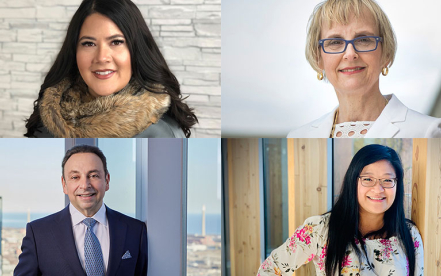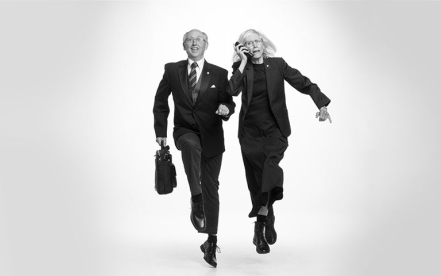Transforming lives through philanthropy at Canada's engaged university
SFU news and research

SFU President Joy Johnson with SFU students
- SFU re-appoints Joy Johnson as president and vice-chancellor for another term: Early in 2024, SFU Board of Governors voted unanimously to re-appoint Joy Johnson as president and vice-chancellor of Simon Fraser University. The further five-year term begins Sept. 1, 2025, and runs to Aug. 31, 2030. Board Chair Angie Lamarsh, who led an extensive review and community consultation, said the board was pleased with Johnson’s performance to date and her ambitious plans for the university.
- Bringing Indigenous culture to the heart of SFU’s Surrey campus: SFU has installed two of four new public works of art to acknowledge, honour and respect the unceded traditional territories of the First Nations, where SFU’s Surrey campus is located. More than static installations, the pieces are platforms for learning that invite audiences to deepen their understanding of the region’s Indigenous peoples’ traditions and their relationship with the land. Our Roots Run Deep, produced by Phyllis Atkins and her son, Noah (Kwantlen First Nation), and Step by Step, by Rain Pierre (Katzie First Nation), are the first two Indigenous art pieces to be installed at the campus.
- Out of this world co-op experience helps chart space dream to the stars: Tianna Sequeira, an SFU student in the School of Sustainable Energy Engineering (SEE), once dreamed of the stars and space exploration. She recently landed a role with the Canadian Space Agency (CSA) and is now working in systems engineering on the Canadian contribution to the NASA-led Lunar Gateway program—a project that will send humans deeper into space thanks to the Simon Fraser University Co-op program.
- Digital repatriation of Tse’k’wa archive democratizes 50 years of archaeological and cultural knowledge: Materials and artifacts from one of the most significant cultural and archaeological sites in B.C. are being digitally repatriated to the Dane-zaa people. Tse'k'wa ("rock house" in Dane-zaa/Beaver language) is a cave that has been home to the Dane-zaa ancestors for more than 12,500 years. SFU’s Knut Fladmark and Jon Driver led excavations there from 1974 to 1991, unearthing artifacts crucial to understanding human habitation from the last ice age to the Second World War. In 2012, the Dane-zaa Nations purchased the property and formed the Tse’k’wa Heritage Society, and it was designated a National Historic Site in 2019. Tse'k'wa’s materials, currently housed at SFU’s Burnaby campus, are being returned digitally, facilitated by John Driver and SFU Library.
- SFU-led B.C. Centre for Agritech Innovation expands funding to boost B.C. food sovereignty: Thirteen new agritech projects aimed at strengthening the province’s food production have received funding from the Simon Fraser University-led B.C. Centre for Agritech Innovation (BCCAI). The 13 projects, announced on Jan. 26 at the 2024 Pacific Agriculture Show in Abbotsford, aim to solve critical challenges facing food producers in B.C., including soil health, pest and pathogen management, Indigenous food sovereignty and training opportunities. Together, they represent a total investment of $2 million, including more than $650,000 from the BCCAI. The BCCAI brings together academia, industry and government to create new opportunities toward food production and security. Located at SFU’s Surrey campus, the BCCAI is funded by the province and the federal government, through Pacific Economic Development Canada (PacifiCan).
- Growing pains? SFU research tracks 100 years of salmon adaptation to climate change: Juvenile salmon in British Columbia are growing larger than they did 100 years ago due to climate change, according to a new Simon Fraser University-led study. Century-old fish scales are yielding new insights into how salmon populations are responding to climate change in northern B.C., and how maintaining the integrity of freshwater habitats may help salmon adapt to warming temperatures. SFU biological sciences Liber Ero Postdoctoral Fellow Michael Price, with other SFU researchers and Fisheries and Oceans Canada, have used modern genetic tools to analyze fish scales collected from fisheries since 1913 to reconstruct the historical growth of juvenile sockeye in various lakes across the Skeena watershed.
- Earth Sciences professor assessing carbon storage potential beneath Metro Vancouver: Professor Shahin Dashtard is looking at the viability of storing large volumes of carbon dioxide in a soda pop-like solution thousands of metres below the streets of Metro Vancouver to help B.C. meet its net-zero emission goals. With business and industry among the highest emitters of greenhouse gas (GHG) emissions in Metro Vancouver, contributing half of the 15 million tonnes of total regional emissions, with industrial facilities accounting for approximately 2.5 million tonnes (17 per cent). While multiple approaches are being implemented to reduce industrial emissions, these are unlikely to achieve carbon neutrality in the industrial sector within the next 30 years.
- IUPP student Morgan Peequaquat finds her voice and a community while organizing the Skoden Indigenous Film Festival: When Morgan Peequaquat transferred to SFU from UBC, she didn’t plan to take a class about Indigenous film or help to plan a film festival in her second semester. CA 389: Selected Topics in the Fine and Performing Arts, is a course that curates and organizes the Skoden Indigenous Film Festival each year. The course is open to any SFU student interested in learning more about Indigenous film and what goes into planning a film festival, and it was an elective available to Morgan as part of the Indigenous University Preparation Pathway (IUPP).


